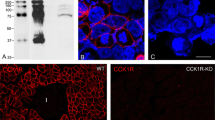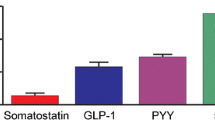Summary
Human duodenal endocrine cells reactive with antibodies to cholecystokinin (CCK) 33 (10–20) and/or gastrin 34 (1–15) were studied by a combination of immunohistochemical and electron-microscopic methods. By immunohistochemistry, three types of endocrine cells were distinguished in human duodenal mucosa, i.e., those only positive for only CCK, those positive for both CCK and gastrin and those only positive for only gastrin. Ultrastructurally, the first cell type is characterized by many secretory granules with an eccentric dense core (mean diameter; 271+-74 nm). The second cell type, which was less frequent than the other two, has ultrastructural features that resemble type-I cells. The last cell type was composed of two types of cells containing small secretory granules identical to those of IG cells (mean diameter; 171+-31 nm) or large secretory granules indistinguishable from those of I cells (mean diameter; 286+-50 nm).
Similar content being viewed by others
References
Buchan AMJ, Polak JM, Solcia E, Capella C, Hudson D, Pearse AGE (1978a) Electron immunohistochemical evidence for the human intestinal I cells as the source of CCK. Gut 19:403–407
Buchan AMJ, Polak JM, Capella C, Solcia E, Pearse AGE (1978b) Electron immunocytochemical evidence of the K cell localization of gastric inhibitory polypeptide (GIP) in man. Histochemistry 56:37–44
Buchan AMJ, Polak JM, Solcia E, Pearse AGE (1979) Localisation of intestinal gastrin in a distinct endocrine cell type. Nature 277:138–140
Buffa R, Solcia E, Go VLW (1976) Immunohistochemical identification of the cholecystokinin cell in the intestinal mucosa. Gastroenterology 70:528–532
Bussolati G, Capella C, Vassallo G, Solcia E (1971) Histochemical and ultrastructural studies on pancreatic A cells. Evidence for glucagon and non-glucagon components of the granules. Diabetologica 7:181–188
Capella C, Solcia E, Frigerio B, Buffa R (1976) Endocrine cells of the human intestine. An ultrastructural study. In: Fujita T (ed) Endocrine gut and pancreas. Elsevier Scientific Publishing Company, Amsterdam, pp 43–59
Deschenes RJ, Narayana SVL, Argos P, Dixon JE (1985) Primary structural comparison of the preprohormones cholecystokinin and gastrin. FEBS Lett 182:135–138
Greider MH, Steinberg V, MuGuigan JE (1972) Electron microscopic identification of the gastric cell of the human antral mucosa by means of immunocytochemistry. Gastroenterology 63:572–583
Larsson L, Jorgesen LM (1978) Ultrastructural and cytochemical studies on the cytodifferentiation of duodenal endocrine cells. Cell Tissue Res 194:79–102
Lechago J (1982) The endocrine cells of the digestive and respiratory systems and their pathology. In: Bloodworth JMB (ed) Endocrine pathology. Williams and Wilkins, Baltimore London, pp 513–555
McGuigan JE, Greider MH (1971) Correative immunochemical and light microscopic studies of the gastrin cell of the antral mucosa. Gastroenterology 60(2):223–236
Mutt V, Jorpes E (1971) Hormonal polypeptides of the upper intestine. Biochem J 125:57–58
Pearse AGE, Coulling I, Weavers B, Friesen S (1970) The endocrine polypeptide cells of the human stomach, duodenum and jejunum. Gut 11:649–658
Polak JM, Pearse AGE, Bloom SR, Buchan AMJ, Rayford PL, Thompson JC (1975) Identification of cholecystokinin-secreting cells. Lancet II: 1016–1018
Polak JM, Pearse AGE, Szelke M, Bloom SR, Hudson D, Facer P, Buchan AMJ, Bryant MG, Christofiodes N, MacIntyre I (1977) Specific immunostaining of CCK cells by use of synthetic fragments antisera. Experientia 33:762–763
Rubin W (1972) Endocrine cells in the normal human stomach. A fine structural study. Gastroenterology 62:784–800
Sasagawa T, Kobayashi S, Fujita T (1970) The endocrine cells in the human pyloric antrum. An electron microscope study of biopsy materials. Arch Histol Jpn 32:275–288
Schlegel W, Raptis S, Grube D, Pfeiffer EF (1977) Estimation of cholecystokinin-pancreozymin (CCK) in human plasma and tissue by a specific radioimmunoassay and the immunohistochemical identification of pancreozymin-producing cells in the duodenum of humans. Clin Chim Acta 80:305–316
Solcia E, Vassallo G, Capella C (1969) Studies on the G cells of the pyloric mucosa, the probable site of gastrin secretion. Gut 10:379–388
Suzuki M, Shimada M, Yamaguchi K, Abe K, Maruno K, Yanaihara N (in press) CCK-immunoreactivity in human tissues. Shokakan horumon. 5:42–46 (in Japanese)
Tsumuraya M, Kameya T (1982) Ultrastructural characterization of human corticotrophs (ACTH cells). Acta Endocrinol 101:484–490
Tsutsumi Y, Osamura RY, Nagura H, Watanabe K, Yanaihara N (1983) Immunohistochemical studies on gastrointestinal hormones in the intestinal metaplasia of the stomach. In: Miyoshi A (ed) Gut peptides and ulcer. Biomedical Research Foundation, Tokyo, pp 171–179
Walsh JH (1981) Gastrin. In: Bloom SR, Polak JM (eds) Gut hormones. Churchill Livingstone, Edinburgh, pp 163–170
Author information
Authors and Affiliations
Rights and permissions
About this article
Cite this article
Tsumuraya, M., Nakajima, T., Morinaga, S. et al. Morphological variation of immunoreactive cells positive to cholecystokinin 33 (10–20) and gastrin 34 (1–15) in human duodenum. Cell Tissue Res. 244, 519–525 (1986). https://doi.org/10.1007/BF00212529
Accepted:
Issue Date:
DOI: https://doi.org/10.1007/BF00212529




